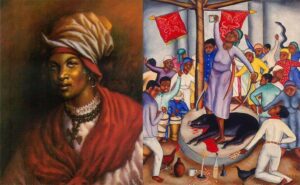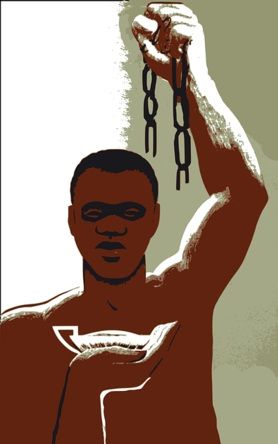
Cécile Fatiman was a Haitian vodoo priestess born in the 18th century. On August 1791, Fatiman presided over a ceremony at the Bois Caïman in the role of mambo together with priest Dutty Boukman.

image from: https://vocalafrica.com/epic-dutty-boukman-story-prayer/
Dutty Boukman (1767-1791)
“God who makes the sun which gives us light, Who rouses the waves and makes the storm, Though hidden in the clouds, he watches us. He sees all that the whites are doing. The God of the whites orders crime, But our God calls upon us to do good works. Our God who is good to us orders us to avenge our wrongs. He will direct our arms and aid us. Throw away the symbol of the god of the whites Who has so often caused us to weep, And listen to the voice of liberty, Which speaks in the hearts of us all.”
–“Voice of liberty” speech by Boukman
Boukman faciltated the religious ceremony at Bois Caïman, in August 1791, with Cecile Fatiman, and this prayer lead space served as the catalyst to the 1791 slave revolt which is usually considered the beginning of the Haitian Revolution. “Boukman prophesied that the slaves Jean François, Biassou, and Jeannot would be leaders of a resistance movement and revolt that would free the slaves of Saint-Domingue. An animal was sacrificed, an oath was taken, and Boukman and the priestess exhorted the listeners to take revenge against their French oppressors. During the ceremony, Cécile Fatiman acted as if she were possessed by the goddess Erzulie. A week later, 1800 plantations had been destroyed and 1000 slaveholders killed.” (https://medium.com/@iloveblackpeopleapp/c%C3%A9cile-fatiman-eca3e52da19d)
Boukman was a key leader of the slave revolt in the Le Cap‑Français region in the north of the colony. He was killed by the French planters and colonial troops on 7 November 1791, just a few months after the beginning of the uprising. The French then publicly displayed Boukman’s head in an attempt to dispel the aura of invincibility that Boukman had cultivated. The fact that French authorities did this illustrates their belief in the importance Boukman held to Haitian people during this time.

Collage of the Haitian Revolution
Le Marron Inconnu de Port au prince

Haitian architect Albert Mangonès completed the statue on 22 September 1967. It measures 3.60 metres long by 2.40 metres high. It depicts in bronze a near-naked fugitive black man, kneeling on one knee, his torso arched, his opposite leg stretched back, and a broken chain on his left ankle. He holds a conch shell at his lips with his left hand, his head tilted upward to blow it, while the other hand holds a machete on the ground by his right ankle.

View of a Sugar Plantation, French West Indies, 1762.

Illustration of the Haitian Revolution
Francois Makandal


François Makandal (or Mackandal) “was an enslaved African runaway and rebel leader in Saint-Domingue (modern Haiti) during the early– to mid-eighteenth century. Little definitive information is known about Makandal except that he was executed in Cap-Français in January 1758 for being a runaway, rebel, and murderer. He was born in Africa and brought to the north of Saint-Domingue to work on a sugar plantation at the age of twelve.”
“No records show his specific origins, historians estimate West Africa Region and he was a powerful figure in the lives of both planters and slaves. After losing an arm in a sugar mill, Makandal was made to care for livestock. He eventually fled the plantation and joined a maroon community where he became a leader. Makandal claimed to have supernatural abilities, which helped him to successfully organize different maroon groups to coordinate their activities. His supernatual claims aside, Makandal did have extensive knowledge of plants and was able to make powerful poisons.”




Recent Comments